If you have chosen a self-pack move this useful guide aims to help you wrap, pack and protect your belongings in preparation for your move.
In this packing guide:
- Packing materials and equipment you will need
- Putting together your moving boxes
- When to start packing and how long it takes
- Using a removal company to do your packing
- Where to start with your packing
- Packing each room and how to best pack particular items
- Packing valuables
- Labelling boxes
- Top tips for packing
- What not to pack
Packing materials and equipment you will need for moving house
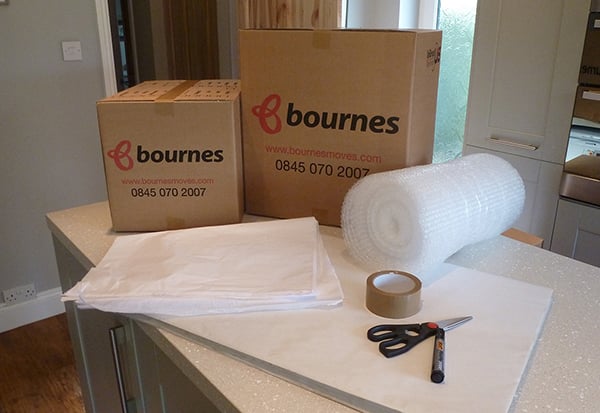
Before you start packing for your move you will need:
- A selection of small, medium and large moving boxes
- Packing tape
- Scissors/Small Knife
- Marker Pen
- Packing paper (Avoid newsprint—it can leave a mark on items)
- A clear surface to pack on
Check out our guide to packing boxes and materials for moving house.
What sort of boxes should I use for moving house?
Best type of box for moving house
Use boxes that are designed for moving house and strong enough for their purpose - don't use old supermarket cartons or fruit boxes. These may be weaker and likely to split or get easily damaged if dropped or rained on!
Choose the right size box for what you are packing
- Small Moving Box - (aka Bournes PK 6) Ideal for Books, Records, Tools, Foodstuff, Heavy Items, Bottles & Liquids - typically holds a 3 foot shelf of books / dvd’s
- Medium Moving Box - (aka Bournes PK 2) Ideal for China, Glassware, Toys, Pans, Electrical small appliances - typically holds the Contents of a single kitchen cupboard
- Large Moving Box - (aka Bournes PK 3 or 4 (layflat)) Ideal for Linen, folded clothes, soft toys, curtains - typically holds Bedding for a single bed OR 2 foot rail of clothes OR 3 drawers of clothes
- Wardrobe Cartons - great for packing hanging clothes if you want to move them on their hangers to avoid folding/creasing.
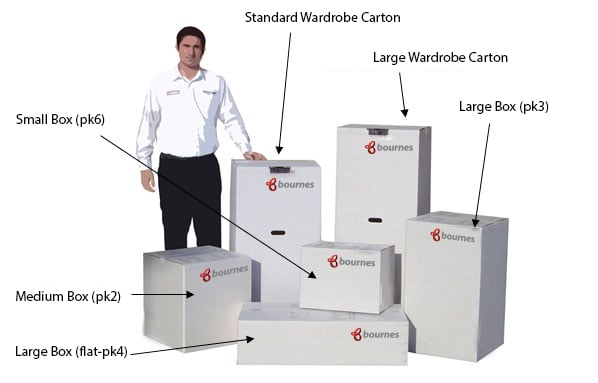
View our packing box size guide here.
Putting together your moving boxes
Assembling your boxes properly for safe loading is really important in reducing the risk of damage. Here's how to do it:
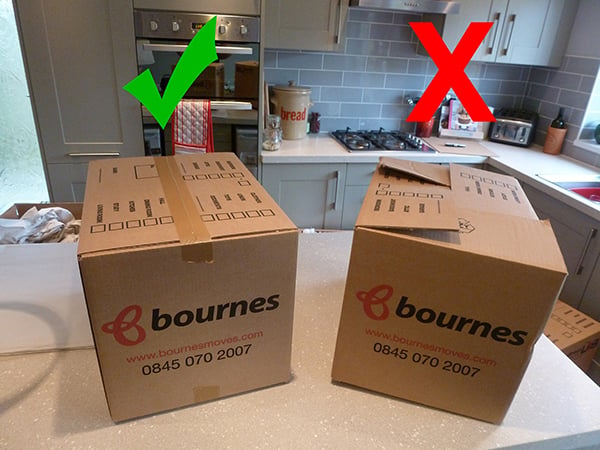
- On one end of the box fold the smaller flaps in first and then fold in the larger flaps.
- Push the sides of the box together until the larger flaps touch tightly and tape the seam. Start taping about 5 inches on the side of the box and continue across the seam and up 5 inches on the opposite side.
- If the box will be filled with heavy items it’s a good idea to put some extra tape as above across the middle of each flap for extra strength.
- Flip the box over so the open end is facing up ready to load. Once your box is full tape across the seam as you did above and label. Don't fold the top of the box criss/cross!
when should i start packing?
Most people start packing at least 3 weeks before their move date, but this really depends on your own circumstances. Consider:
- How much spare time do you have? Are you going to be able to dedicate lots of time to packing to get it all done at once or do you need to do a little bit each day? if so - start earlier!
- How long can you live without your things? Are there lots of items you can pack up ahead of time without missing them or do you use most of your belongings frequently? If you need frequent access then it's best to pack as close to your moving date as possible.
- Do you have space to keep packed boxes? If you have lots of space to keep finished boxes out of the way that's great, but if your home is small and the boxes will get in your way you might not want to start too early.
How long does it take to pack for a house move?
A professional removals crew can pack an average 3 bedroom house in 5-8 hours, but if you are packing your own belongings allow longer than that! Aside from the fact that removals professionals are well practised and could pack with their eyes closed, they don't have the emotional attachment and don't lose time "looking" at things.
Using a removal company to do your packing
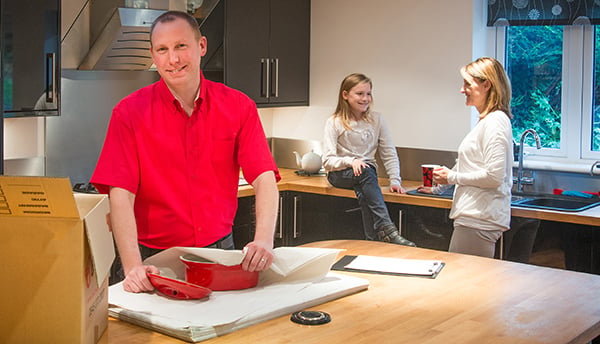
This is our number one tip. A significant amount of the stress of moving house comes from packing, so use a removal company with packing services to do this for you if you can. There are lots of reasons we advise this:
- Saves you time - it can take weeks for an individual to pack their own home. Depending on the size of your move a removal company may be able to pack, move and unload everything in a single day!
- Reduces the risk of items getting damaged - movers are professionally trained in how to best pack all types of items for transport. They use specially designed materials and have years of experience in what to do to protect your items in the best way.
- Reduces stress - having to live amongst boxes for several days or suddenly realising you need something you packed weeks ago can be really stressful, especially at a time you're likely to be anxious anyway. Letting a removal company handle packing for you can alleviate this.
Removal companies often offer different levels of packing service so they can pack all or just some of your items, for example just the fragile things. Check out our packing options for removals to find out more.
Where to start with your packing
Getting organised before you start packing is a great way to reduce the stress. Here's a few top tips to help you get organised:
De-clutter before packing
It can take a lot of time to sort through what you want to take to your new home and what you don't so doing it whilst you're packing is not ideal. Try to de-clutter before you start packing so that the actual packing process is simply a case of wrapping items and packing them into boxes. Check out our top tips for de-cluttering for moving house.
Decide which rooms to tackle first
Start with the rooms/areas you use least - storage spaces like the loft, garage or spare rooms are a great place to start - you can also free up space to store your packed boxes from elsewhere. Try to stick to one room/area at a time rather than moving between as this will help you pack quicker.
how to pack each room you are moving
Packing the kitchen
Which Box?
Medium Box (Bournes pk2) - you can load a mix of kitchen items into a box, try to keep fragile items together and ensure the weight of the box does not get too heavy.
Wrapping Glasses
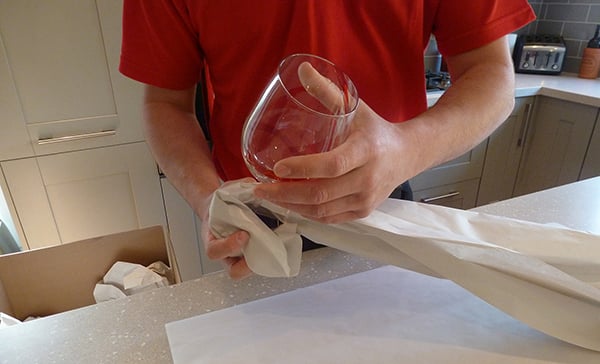
- Lay out a piece of packing paper and place the glass on its side diagonally near the corner of the paper. Pull up the corner around the glass and roll away from you folding the spare ends of the paper into the globe and around the stem as you go creating a tube shape.
- Repeat the process with a second sheet of paper to provide extra padding.
- Place the glass vertically into the box.
Watch our video on how to pack glasses
Wrapping Plates / Bowls
- Take a stack of packing paper and place the first plate/bowl in the centre.
- Fold one corner of the paper over the plate/bowl until it is completely covered.
- Place another plate/bowl on top and fold in the remaining three corners, secure the paper with packing tape.
- Stack plates on their edges in the box, don’t lay flat, plates are much stronger on their ends and can sustain a lot more pressure.
Watch our video on how to pack plates and bowls
Packing kitchen boxes
Once your smaller items are wrapped you can start loading them into the packing box.
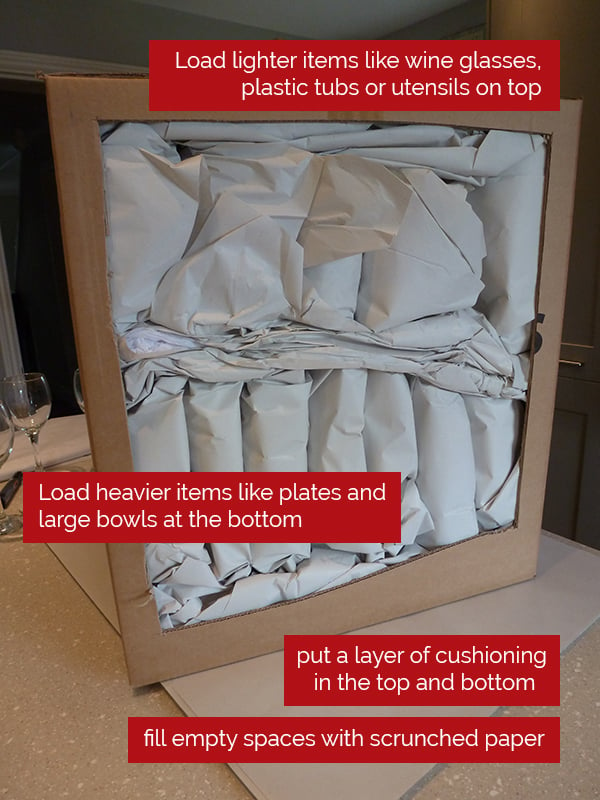
- Line the box with scrunched up paper to provide a layer of cushioning. You could also use soft items like oven gloves, folded aprons or tea towels for the padding.
- Load your heavy items (china etc) in the bottom and lighter items on top. Plates make a good base layer with glasses and bowls making up a good 2nd layer.
- Fill any empty space with scrunched up paper to prevent movement, try gently shaking the box, if it rattles then you may need a little more filling.
- If the box is starting to get heavy fill the remainder with lighter items such as Tupperware, utensils or plastic mixing bowls etc to utilise the space but keep the weight manageable.
- Seal your box across the top seam with packing tape and label indicating the room it should go into and a description of contents.
- If the contents are fragile make sure to indicate this on all sides and on the top of the box so that when the box is being transported the crew can easily identify extra care is required and carefully choose a loading position on the vehicle.
Packing Food for moving house
- DO NOT pack perishable items.
- Tape the tops of open boxes of food to ensure they don’t get spilt.
- Place easy spill items inside a sealable plastic bag.
- Wrap glass bottles in paper and load upright.
- Use smaller containers within boxes to pack small loose items such as herbs and spices.
- Keep an eye on the weight of your box, remember bottles and cans get heavy!
Packing Small Appliances
- Make sure all appliances are clean and dry before packing.
- Remove any loose parts (such as microwave plates) and pack separately.
- If you still have original packaging use it. If not choose the appropriate sized small or medium carton depending on the item weight.
- Wrap the appliance in a couple of sheets of packing paper making sure to protect any protruding arms or levers and secure with tape before placing in the box.
- You can fill a box with several small appliances or use the remaining space for other non fragile items. Remember to fill any empty spaces with scrunched paper to prevent things rattling around.
Kitchen Packing Hacks and Tips
- If your sharp knives come in a knife block wrap this all up together, if they don’t then wrap them individually
- Utilise the empty space in pots and pans by placing smaller items inside, and invert the lid
- Things with handles—use an extra piece of paper folded lengthways to wrap around the handle to give extra protection.
- Bowls/pans with lids—wrap once and then place the lid on top, inverted, before wrapping in a second sheet of paper.
Packing the lounge and other living areas
Which Box?
This depends on what you're packing in them. Cushions or blankets can use large boxes, ornaments etc. might go into a medium box and books should go into small boxes. The key is to work out the best size box to fill it up well enough that things don't rattle around without loading it so heavy you can't lift it.
Packing Books
Use a small Box (Bournes pk6) - book boxes can get heavy quickly so don’t be tempted to over-fill these boxes. Try using half the box for books and half for lighter items like DVD’s to keep the weight reasonable.
- Sort your books into hard cover and paper back and try to group by size.
- Place the books in their groups into the box, they can either be stacked like on a bookshelf or laid flat, keep spines against the edge of the box and not the paper edges. To prevent damage don’t place books with the paper edges down and spines up, this can leave items warped or bent. You can use a mix of methods to fill the space well.
- Expensively bound volumes or books with particular value should be individually wrapped in packing paper before loading.
- Fill any empty space in the box with scrunched up packing paper to stop the contents moving around too much in transit.
- Fold over the top flaps on the box and seal with tape. Remember to label the box clearly to indicate which room it is to be placed in at destination (if you know) and a description of its contents.
Watch our video guide to packing books for moving house.
Wrapping figurines and small fragile items
Figurines and small fragiles can be loaded within either small or medium cartons with other items, depending on their weight.
- Wrap in a layer of tissue paper or facial tissues before overwrapping with packing paper
- Use bubble wrap for particularly fragile items especially those with pieces protruding or with delicate areas.
- Be sure to use plenty of padding around the item when loading to cushion it from other items in the box and prevent movement.
Watch our video guide to packing ornaments.
Packing bedrooms
Which Box?
Large moving boxes (either upright or layflat) are great for packing clothes, bedding and other light but bulky items. Medium and small boxes can be used for ornaments, books etc. Again, the key is to keep boxes at a manageable weight to lift without things rattling around inside.
Packing clothes
If you're using a removal company ask if they provide wardrobe boxes. Many, like Bournes, will bring these along on move day so you can leave hanging clothes in the wardrobe and they will load them up and transport them on their hangers to avoid creasing.
Items from drawers should be packed folded and you should line your box with packing paper before loading. Check out our video guide to packing clothes.
Another great idea for packing clothes is zipped laundry bags, as suggested by Community Ad in their top 5 tips for moving house.
Packing the bathroom
Be really careful if you're packing any liquids. It's a good idea to place liquids and cosmetics into a sealed container before packing to ensure other boxes and items are protected if there is a leak.
You can use towels to protect any fragile items, or to provide cushioning in other boxes where they wont get damaged.
Take care to pack mirrors safely using a picture carton. Check out our video guide to packing pictures and frames. Mirrors follow the same principles!
Packing Valuables
Valuables should ideally be packed all together in a box that you will keep with you during the move. Think about including:
- Important paperwork like passports
- Jewellery
- Sentimental items
Ensure if your removal company are packing or moving these items that you have got the right level of insurance cover in place should an accident happen. It's also a great idea to take a photo before packing.
What not to pack when you move
Don't pack anything hazardous that might cause damage to other items or a risk to health and safety
Most removal companies advise you not to move hazardous items - things like flammables, toxic or corrosive substances, explosives (like fireworks) etc. should not be packed. These might also include items you wouldn't expect like paint, some cleaning products or batteries etc, so always check with your removal company if there is anything you should not be packing.
Don't pack anything valuable
See our notes on packing valuables above.
Don't pack anything that doesn't belong to you!
This might sound odd, but if you live in rented accommodation then don't forget to leave behind anything that came with the property! If you live in a furnished property this might include things like lamps or pictures, but even when you live in unfurnished property make sure you don't pack things like window keys, gas meter keys or doormats!
Labelling boxes for your move
Labelling your boxes well will save you lots of time when you're unpacking, so make sure to clearly label your boxes as you go.
Here's how to label your boxes for moving house.
tips for packing to move house
- De-clutter before you start packing
- Consider using a removal company to do your packing - they can do all or just some (e.g. fragiles)
- Use the right packing boxes and materials - specially designed moving boxes, quality packing tape and paper (not newspaper as the print can rub off) - and make sure your boxes are assembled correctly.
- Fill any gaps with scrunched paper to give good cushioning for any movement.
- Don’t make your boxes too heavy to lift or that they do not easily close.
- If you are packing plates/dishes pack them on their sides, they will be sturdier.
- Pack an essentials box with all the things you’ll need first at your new home (for example drinking glasses, scissors, toilet tissue)
- Pack an 'odds' box for fiddly things that could be lost easily (for example keys, TV remote controls).
- Carry Passports or valuable Jewellery with you rather than packing in a box.
- Make sure you’re aware of what items cannot be packed like household cleaners, petrol/oil, paints and potentially harmful products – ask your removal company to advise if you're not sure.
- Leave plenty of time to pack, it may take longer than you think!
- Consider insurance implications of packing your own items – ask your removal company what the insurance cover provides for owner packed boxes.
You might also be interested in:

.png)









